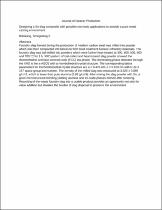 ResearchSpace
ResearchSpace
Designing a Sn-slag composite with possible non-toxic applications to provide a pure metal casting environment
JavaScript is disabled for your browser. Some features of this site may not work without it.
- ResearchSpace
- →
- Research Publications/Outputs
- →
- Journal Articles
- →
- View Item
| dc.contributor.author |
Bolokang, Amogelang S

|
|
| dc.date.accessioned | 2023-03-20T09:42:04Z | |
| dc.date.available | 2023-03-20T09:42:04Z | |
| dc.date.issued | 2019-02 | |
| dc.identifier.citation | Bolokang, A.S. 2019. Designing a Sn-slag composite with possible non-toxic applications to provide a pure metal casting environment. <i>Journal of Cleaner Production, 211.</i> http://hdl.handle.net/10204/12689 | en_ZA |
| dc.identifier.issn | 0959-6526 | |
| dc.identifier.issn | 1879-1786 | |
| dc.identifier.uri | https://doi.org/10.1016/j.jclepro.2018.11.250 | |
| dc.identifier.uri | http://hdl.handle.net/10204/12689 | |
| dc.description.abstract | Foundry slag formed during the production of medium carbon steel was milled into powder which was then compacted into blocks to form heat treatment furnace refractory materials. The foundry slag was ball-milled into powders which were further heat-treated at 300, 400, 500, 600 and 700 °C for 1 h. XRD pattern of ball-milled and heat-treated slag powder showed the rhombohedral and face-centred cubic (FCC) eta-phase. The dominating phase detected through the XRD is the a-Al2O3 with a rhombohedral crystal structure. The corresponding lattice parameters for therhombohedral crystal structure are a = 0.476 nm; c = 0.129 nm with R-3c # 167 space group and number. The density of the milled slag was measured at 3.325 ± 0.085 g/cm3, which is lower than pure alumina (3.69 g/cm3). After mixing the slag powder with Sn, a good microstructural bonding yielding alumina and tin oxide phases formed after sintering. Recycling of the waste foundry slag into a usable product provides an opportunity not only for value addition but eliviates the burden of slag disposal to preserve the environment. | en_US |
| dc.format | Abstract | en_US |
| dc.language.iso | en | en_US |
| dc.relation.uri | https://www.sciencedirect.com/science/article/pii/S0959652618336539 | en_US |
| dc.source | Journal of Cleaner Production, 211 | en_US |
| dc.subject | Alumina | en_US |
| dc.subject | Annealing | en_US |
| dc.subject | Density | en_US |
| dc.subject | Sn-slag composite | en_US |
| dc.subject | Spinel structures | en_US |
| dc.title | Designing a Sn-slag composite with possible non-toxic applications to provide a pure metal casting environment | en_US |
| dc.type | Article | en_US |
| dc.description.pages | 1313-1321 | en_US |
| dc.description.note | © 2018 Elsevier Ltd. All rights reserved. Due to copyright restrictions, the attached PDF file only contains the abstract of the full text item. For access to the full text item, please consult the publisher's website: https://doi.org/10.1016/j.jclepro.2018.11.250 | en_US |
| dc.description.cluster | Manufacturing | en_US |
| dc.description.impactarea | Fundamental Properties & Modelling | en_US |
| dc.identifier.apacitation | Bolokang, A. S. (2019). Designing a Sn-slag composite with possible non-toxic applications to provide a pure metal casting environment. <i>Journal of Cleaner Production, 211</i>, http://hdl.handle.net/10204/12689 | en_ZA |
| dc.identifier.chicagocitation | Bolokang, Amogelang S "Designing a Sn-slag composite with possible non-toxic applications to provide a pure metal casting environment." <i>Journal of Cleaner Production, 211</i> (2019) http://hdl.handle.net/10204/12689 | en_ZA |
| dc.identifier.vancouvercitation | Bolokang AS. Designing a Sn-slag composite with possible non-toxic applications to provide a pure metal casting environment. Journal of Cleaner Production, 211. 2019; http://hdl.handle.net/10204/12689. | en_ZA |
| dc.identifier.ris | TY - Article AU - Bolokang, Amogelang S AB - Foundry slag formed during the production of medium carbon steel was milled into powder which was then compacted into blocks to form heat treatment furnace refractory materials. The foundry slag was ball-milled into powders which were further heat-treated at 300, 400, 500, 600 and 700 °C for 1 h. XRD pattern of ball-milled and heat-treated slag powder showed the rhombohedral and face-centred cubic (FCC) eta-phase. The dominating phase detected through the XRD is the a-Al2O3 with a rhombohedral crystal structure. The corresponding lattice parameters for therhombohedral crystal structure are a = 0.476 nm; c = 0.129 nm with R-3c # 167 space group and number. The density of the milled slag was measured at 3.325 ± 0.085 g/cm3, which is lower than pure alumina (3.69 g/cm3). After mixing the slag powder with Sn, a good microstructural bonding yielding alumina and tin oxide phases formed after sintering. Recycling of the waste foundry slag into a usable product provides an opportunity not only for value addition but eliviates the burden of slag disposal to preserve the environment. DA - 2019-02 DB - ResearchSpace DP - CSIR J1 - Journal of Cleaner Production, 211 KW - Alumina KW - Annealing KW - Density KW - Sn-slag composite KW - Spinel structures LK - https://researchspace.csir.co.za PY - 2019 SM - 0959-6526 SM - 1879-1786 T1 - Designing a Sn-slag composite with possible non-toxic applications to provide a pure metal casting environment TI - Designing a Sn-slag composite with possible non-toxic applications to provide a pure metal casting environment UR - http://hdl.handle.net/10204/12689 ER - | en_ZA |
| dc.identifier.worklist | 22140 | en_US |





